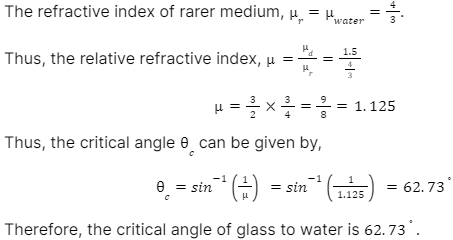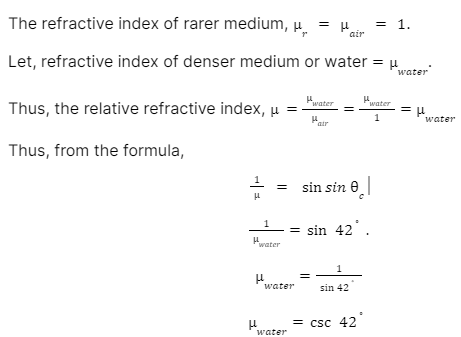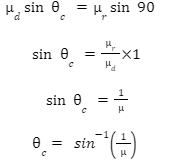Total internal reflection occurs due to the refraction of light. When light travels from one medium to another the direction as well as the speed of light changes. This phenomenon is known as the refraction of light. The driving force of refraction is change of optical density of the medium. Optical density and real density of the medium is not the same. For example, the density of water is greater than the density of oil, but oil is optically denser than water.
Optical density of a medium can be measured by the parameter refractive index. Refractive index of a medium is nothing but the ratio of speed of light in the considered medium and speed of light in space. It generally represented by .
μ=V / VO
Here,
V= Speed of light is considered medium.
VO= Speed of light in space.
Thus, for an optically denser medium value of is higher.
Also, from Snell’s law of refraction,
1 i =2 r
Here,
1= Refractive index of medium-1.
i= Incident angle.
2= Refractive index of medium-2.
r= Refraction angle.
Change of the direction of light ray due to refraction
In general, a light ray travels in a straight line. But, if there is a change in medium, then the light ray changes its direction. When the light ray is going from a rarer medium to a denser medium, then the light ray changes its direction towards the normal of the surface (Fig. 1). Whereas, when the light ray is going from a denser medium to a rarer medium, then the light ray changes its direction towards the boundary of two mediums or away from the normal of the surface (Fig. 2).
Fig. 1: Refraction of light wave from rarer to denser medium
Fig. 2: Refraction of light wave from denser to rarer medium
Concept of Critical Angle
Total Internal Refraction (also abbreviated as TIR) is an example of refraction of light from denser medium to rarer medium. When a light ray passes from a denser medium to a rarer medium, the light ray changes its direction away from the normal of the surface. Thus, the incident angle i becomes lesser than the refraction angle r, that is i<r.
Now, if we change the incident angle of light ray, then the refraction angle also changes and at a certain point, refraction angle becomes 90. In those cases, the light ray passes along the boundary of two mediums after refraction. The certain incident angle is known as the critical angle (denoted by c) of those two considered medium.
Fig. 3: Critical angle
Now, let the refractive index of denser medium is d and the refractive index of rarer medium is r. For, critical angle,
Incident angle, i=c.
Refraction angle, r=90.
Thus, from the Snell’s law,
Here, μ= relative refractive index of two mediums =dr.
Example 1: If the refractive index of water is 43 and the refractive index of glass is 1.5, then find the critical angle when a light ray passes from glass to water medium.
Solution: The refractive index of denser medium, d=glass=1.5.

Solution: The critical angle of water to air, c=42.

μwater=1.49
Therefore, the refractive index of water is 1.49.
Formation of Total Internal Reflection
So, as of now we learned about the critical angle, in which the light ray passes through the boundary of two mediums. Now, if the refraction angle is greater than 90Then the light ray does not go to the second medium (rarer) but completely reflects back to the first medium (denser) and this phenomenon is known as Total Internal Reflection or TIR.
Fig. 4: Total Internal Reflection
Examples of Total Internal Reflection
There are some examples of Total Internal Reflection in the real world. Such as,
This phenomenon can be used to build various kinds of optical instruments such as telescopes, microscopes, binoculars, spectroscopes, periscopes etc.
The most popular application for total internal reflection is optical fibre, which is used to transfer data from one place to another.
The phenomenon of mirage is an absolute example of total internal reflection.
Conclusion
When light travels from one medium to another the direction as well as the speed of light changes. This phenomenon is known as the Refraction of light. The driving force of refraction is change of optical density of the medium. Optical density and real density of the medium is not the same. For example, the density of water is greater than the density of oil, but oil is optically denser than water. Optical density of a medium can be measured by the parameter Refractive index.
 Profile
Profile Settings
Settings Refer your friends
Refer your friends Sign out
Sign out







